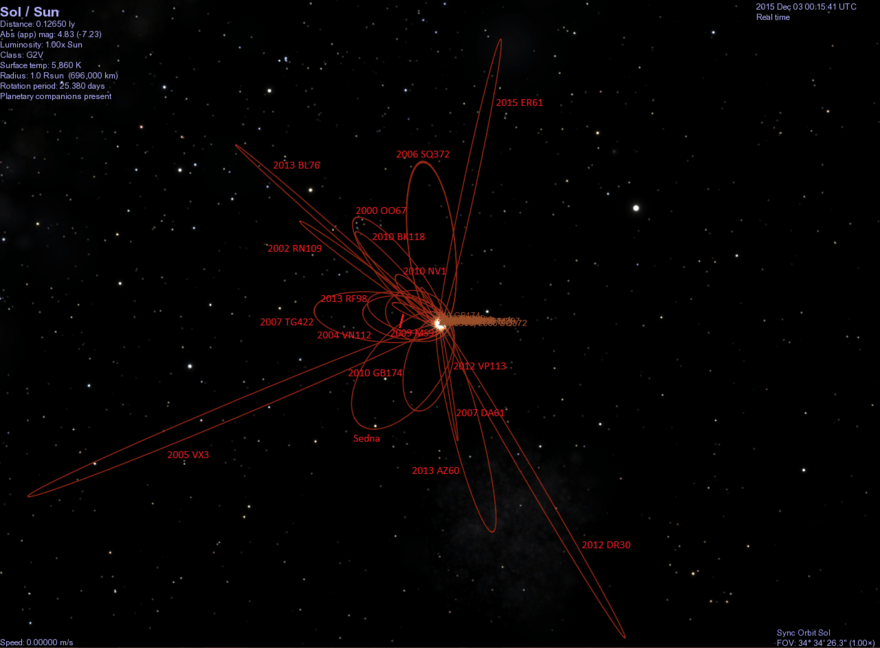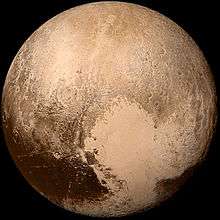(474640) 2004 VN112
| Discovery [1] | |
|---|---|
| Discovered by | Cerro Tololo Obs. |
| Discovery site | Cerro Tololo Obs. |
| Discovery date | 6 November 2004 |
| Designations | |
| MPC designation | (474640) 2004 VN112 |
|
TNO [2] · E-SDO (detached object)[3] | |
| Orbital characteristics[3][2] | |
| Epoch 31 July 2016 (JD 2457600.5) | |
| Uncertainty parameter 2 | |
| Observation arc | 5821 days (15.94 yr) |
| Aphelion |
589 AU (88.1 Tm) (Q) 607 AU (barycentric)[4] |
| Perihelion | 47.325 AU (7.0797 Tm) (q) |
|
318 AU (47.6 Tm) (a) 327 AU (barycentric)[4] | |
| Eccentricity | 0.8513 (e) |
|
5676 yr (2073304 d) 5900 yr (barycentric)[4] | |
| 0.437° (M) | |
| 0° 0m 0.617s /day (n) | |
| Inclination | 25.5710° (i) |
| 65.9985° (Ω) | |
| 327.114° (ω) | |
| Physical characteristics | |
| Dimensions |
314 km (based on expected albedo)[5] 130–300 km[2][6] |
| 0.04 (expected)[5] | |
| Blue[5] | |
| 23.3[7] | |
| 6.4[2] | |
|
| |
(474640) 2004 VN112, provisional designation 2004 VN112, is a detached object[3] (because its perihelion is greater than 40 AU). It never gets closer than 47 AU from the Sun (near the outer edge of the main Kuiper belt) and averages more than 300 AU from the Sun. Its large eccentricity strongly suggests that it was gravitationally scattered onto its current orbit. Because it is, like all detached objects, outside of the current gravitational influence of Neptune, how it came to have this orbit cannot yet be explained. It has only been observed 31 times over six oppositions.[2] For comparison, Sedna has been observed 88 times.[8] Sedna and 2000 CR105 have similar orbits (perihelion greater than 40 AU and semi-major axis greater than 200 AU).
2004 VN112 was observed by the Hubble Space Telescope in November 2008.[1] It reached perihelion (closest approach to the Sun) in 2009[2] and is currently 47.6 AU from the Sun.[7] It will be in the constellation of Cetus until 2019. It comes to opposition at the start of November.
Michael Brown's website lists it as a possible dwarf planet with a diameter of 314 kilometres (195 mi) based on an assumed albedo of 0.04.[5] The albedo is expected to be low because the object has a blue (neutral) color.[5] However, if the albedo is higher, the object could easily be half that size.
This minor planet is one of twelve objects discovered in the Solar System to have a semi-major axis > 150 AU, a perihelion beyond Neptune, and an argument of perihelion of 340 ± 55°.[9] Of these, only five, including 2004 VN112, have perihelia beyond Neptune's current influence.
2004 VN112's orbit is very similar to that of 2013 RF98, indicating that they may have both been thrown onto the orbit by the same body, or that they may have been the same object at one point.
Comparison

See also
References
- 1 2 "(474640) 2004 VN112 Orbit". IAU Minor Planet Center. Retrieved 18 November 2016.
- 1 2 3 4 5 6 "JPL Small-Body Database Browser: (2004 VN112)". Retrieved 30 March 2016.
- 1 2 3 Marc W. Buie (2007-11-08). "Orbit Fit and Astrometric record for 04VN112". SwRI (Space Science Department). Retrieved 2008-07-17.
- 1 2 3 Horizons output. "Barycentric Osculating Orbital Elements for 2004 VN112". Retrieved 2016-01-23. (Ephemeris Type:Elements and Center:@0)
- 1 2 3 4 5 Michael E. Brown. "How many dwarf planets are there in the outer solar system? (updates daily)". California Institute of Technology. Retrieved 18 September 2016.
- ↑ "ABSOLUTE MAGNITUDE (H)". NASA/JPL. Retrieved 2008-02-28.
- 1 2 "AstDyS 2004 VN112 Ephemerides". Department of Mathematics, University of Pisa, Italy. Retrieved 2014-03-28.
- ↑ "JPL Small-Body Database Browser: 90377 Sedna (2003 VB12)". Retrieved 2014-03-28.
- ↑ "JPL Small-Body Database Search Engine: a > 150 (AU) and q > 30 (AU) and data-arc span > 365 (d)". JPL Solar System Dynamics. Retrieved 2014-04-09.
External links
- Orbital simulation from JPL (Java) / Horizons Ephemeris
- JPL Small-Body Database Browser
- (474640) 2004 VN112 at the JPL Small-Body Database

_(cropped).jpg)
